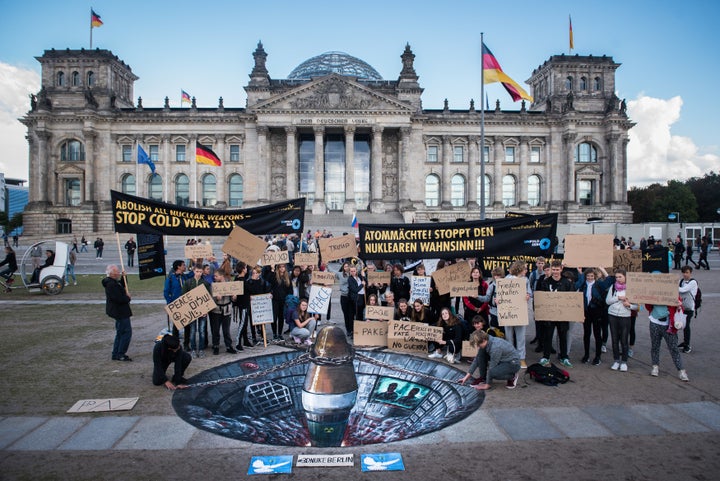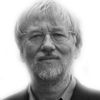This article is posted to commemorate today’s International Day for the Total Elimination of Nuclear Weapons – a day designated by the UN General Assembly to enhance public awareness and education about the threat posed to humanity by nuclear weapons and the necessity for their total elimination.
Co-authored by Rob van Riet

Nuclear testing at Bikini Atoll, 1946.
On 18 September, news broke that Stanislav Petrov, a former Soviet military officer not widely known to the public, had passed away. It was by mere chance that news outlets learned of his passing, after a friend had called earlier this month to congratulate Petrov on his birthday, only to be informed by his son that he had died in May. The reason why media outlets picked up this news of someone dying in relative obscurity is both fascinating and terrifying — and most importantly, as relevant as ever. To understand why, we have to go back 34 years to this very day.
On 26 September 1983, Petrov was the duty officer tasked with registering apparent incoming enemy missiles in a bunker near Moscow. In the early hours of that morning, the early-warning systems lit up, showing first one and then four more missiles being fired from the United States, heading for the Soviet Union. The Soviet military protocol dictated retaliation with a nuclear attack of its own. Petrov, amid the scramble of panic among his 200 subordinates, decided not to report these missile alerts to his superiors, and instead dismissed them as a false alarm. He would later explain: “I had a funny feeling in my gut. I didn’t want to make a mistake. I made a decision, and that was it.”[1] In the 2014 documentary ‘The Man who Saved the World’, which documents Petrov’s life and, in particular, his actions on that fateful morning, he elaborated: “I refused to be guilty of starting World War III (…) If I made the wrong decision, a lot of people will die. A lot of people will die.” It turned out later that what had been mistaken by the satellites as missiles were in fact rays of sunlight reflected on the clouds. Rather than being applauded for preventing a nuclear war based on a glitch, Petrov received a minor reprimand for failing to follow protocol and the episode was buried as highly classified for more than 10 years.[2] The subsequent dissemination of his story to an international audience has made Petrov known as the person who may very well have saved the world.

Stanislav Petrov in the kitchen of his flat in Frjasino.
The retelling of Petrov’s remarkable story comes at a particularly timely moment. While the Cold War may be over, the nuclear threat has not gone away. Consider this: the news of Petrov’s passing came a day before US President Donald Trump used a speech at the UN General Assembly to threaten to “totally destroy” North Korea, as part of an escalating crisis between both countries over Pyongyang’s nuclear weapons programme. At the time of this writing, the crisis has further escalated with North Korea calling the firing of its rockets at the US mainland “inevitable”. Just like in those Cold War days, with increased tension comes a heightened risk of an accidental nuclear missile launch, or a deliberate launch in response to a false warning. With nerves through the roof, a similar false alarm could show up on the radar screen of a duty officer who doesn’t share Petrov’s critical faculties or reluctance to follow protocol knowing it could lead to an all-out nuclear conflagration. The situation becomes particularly worrying when you consider that the United States still keeps its 450 silo-based nuclear weapons, and hundreds of submarine-based weapons, on hair-trigger alert—a policy, which keeps warheads ready to launch within minutes.
But this current nuclear flashpoint points to a larger issue: there is a tremendous deal of complacency among the nuclear-armed states and their allies when it comes to their stewardship of these uniquely destructive weapons. Another look at Petrov’s life is enlightening here. Petrov was born on 7 September 1939. Unbeknownst to anyone at the time, just over a month earlier, Albert Einstein had written to US President Roosevelt, expressing his concern over the Nazi’s efforts to build a bomb which could capture the explosive power of a nuclear chain reaction. By doing so, he played a key role in setting in motion the chain of events that would lead to the creation of the Manhattan Project, which developed the first atomic bomb (Einstein deeply regretted his role in this until his death). Petrov’s life was thus in a way inextricably linked to the nuclear age. He was born when humanity was on the precipice of entering an unprecedented phase in its history—to have the power to extinguish itself.

In October 2016, the World Future Council organised an 3D art project in Berlin with a nuclear missile calling for global disarmament.
For those who like to point out that we’ve done rather well so far in avoiding a nuclear holocaust, it’s worth pointing out that, seen on a longer time-scale, it has only been a blink of an eye in the story of human development since we’ve learnt this new self-destructive trick. When the 200,000-year timeline of modern humans is reduced to a 24-hour day, this age of what World Future Council member David Krieger has called ‘omniscide’, takes up only the last 30 seconds. Think about that and then consider how complacent it would be to infer from it any guarantee of success for the future.
Which brings us back to the crisis in North East Asia. The World Future Council has supported an Appeal for a diplomatic solution in North East Asia, which was launched in response to the escalating crisis. It, inter alia, promotes a phased and comprehensive approach for a North-East Asian Nuclear-Weapon-Free Zone with a 3+3 arrangement, which would require Japan, South Korea and North Korea agreeing not to possess or host nuclear weapons, and China, Russia and the USA agreeing not to deploy nuclear weapons in those countries, or to attack or threaten to attack them with nuclear weapons.[3] In October last year, the World Future Council together with Parliamentarians for Nuclear Non-proliferation and Disarmament and the Inter-Parliamentary Union organised a parliamentary workshop with delegates from all countries in the region to discuss ways to advance this proposal.
Such proposals can only advance if sustained political will is invested in them. As long as nuclear weapons exist, there is the possibility of a nuclear war erupting by intent or miscalculation and mishap. Thirty-four years on from Petrov’s harrowing morning, we find ourselves in a situation where a similar incident could very well occur. We might not be so lucky this time around. We owe it to Petrov to not just retell his story, but to learn from it. The current crisis in North East Asia is as good a place as any to start.
[2] Now, before you lay your head on your pillow this evening resting assured that this was only one freak accident in over 70 years of nuclear operations, in reality, there is no shortage of mistakes and incidents that have brought us close to a nuclear catastrophe. Eric Schlosser documents some of these incidents in his book ‘Command and Control’, which paints a harrowing picture of human error and folly, technological faults and, ultimately, sheer luck.
[3] You can read more about the proposal here: https://nautilus.org/napsnet/napsnet-special-reports/a-northeast-asia-nuclear-weapon-free-zone-with-a-three-plus-three-arrangement/.
